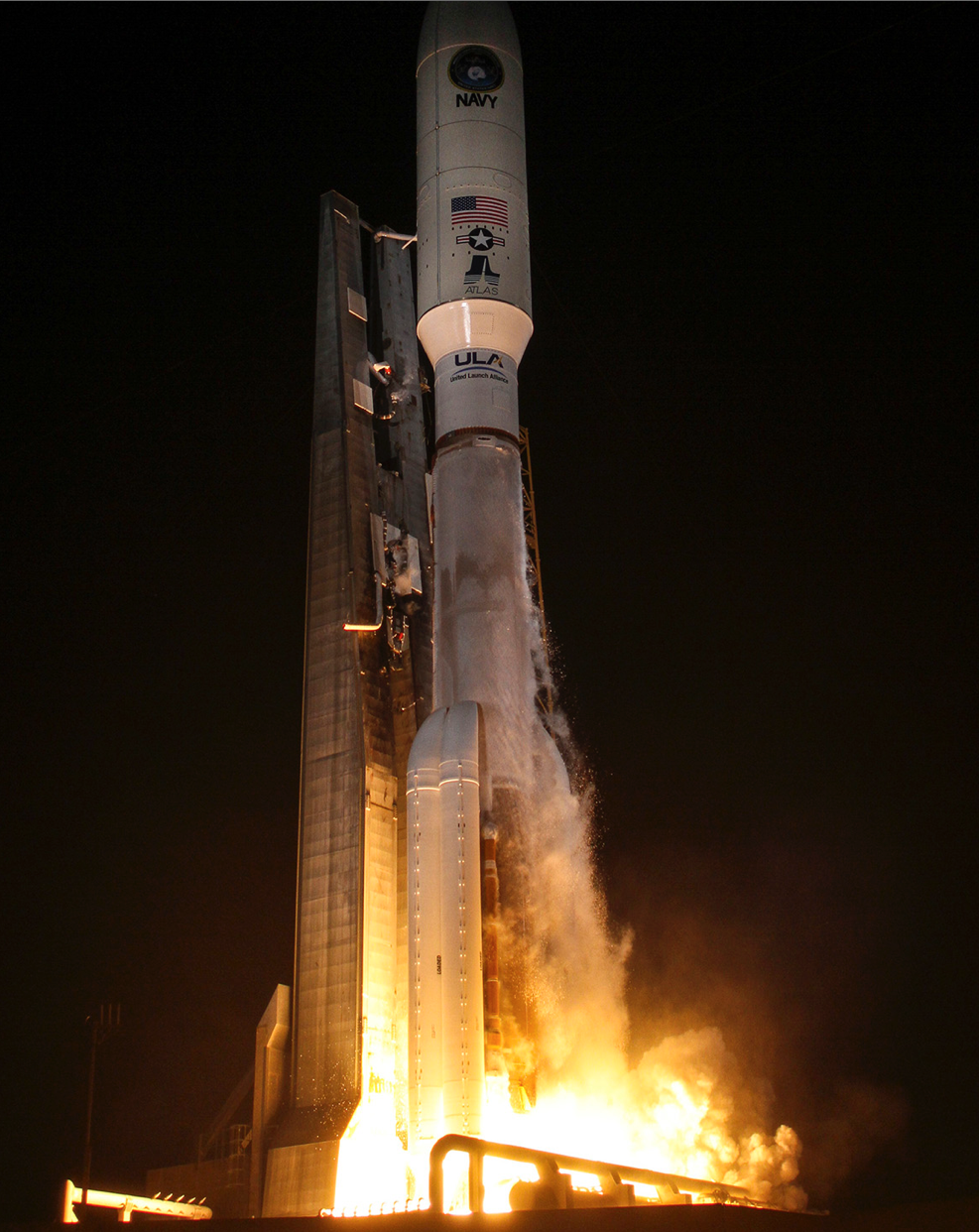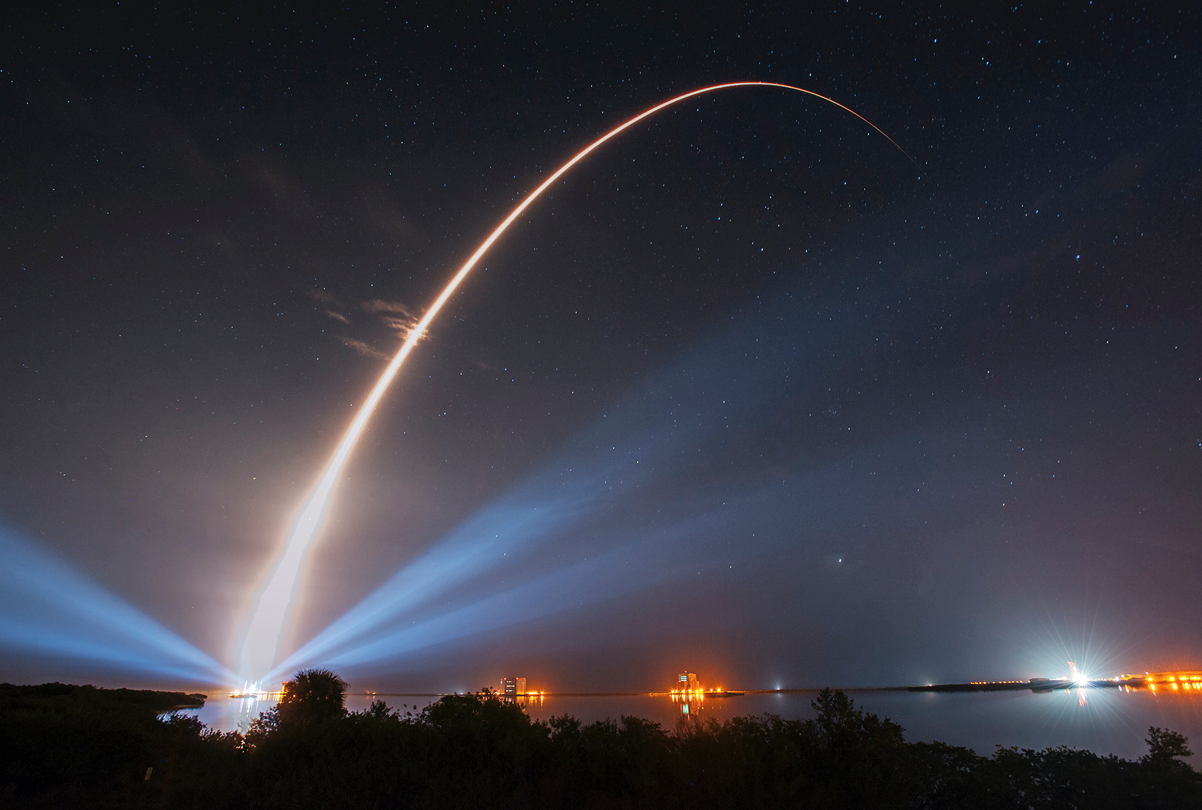
Cape Canaveral Air Force Station, Fla., (Jan. 20, 2015) – A United Launch Alliance (ULA) Atlas V rocket carrying the third Mobile User Objective System satellite for the United States Navy launched from Space Launch Complex-41 at 8:04 p.m. EST today. The MUOS-3 spacecraft will ensure continued mission capability of the existing Ultra High Frequency Satellite Communications system that will provide improved and assured mobile communications to the warfighter. Photo Credit: United Launch Alliance
[SatNews] An Atlas V rocket lifted off creating a beautiful night launch in Florida, carrying the third Mobile User Objective System satellite for the United States Navy.
Announcement from ULA
Cape Canaveral Air Force Station, Florida, (January 20, 2015) – A United Launch Alliance (ULA) Atlas V rocket carrying the third Mobile User Objective System satellite for the United States Navy launched from Space Launch Complex-41 at 8:04 p.m. EST today. The MUOS-3 spacecraft will ensure continued mission capability of the existing Ultra High Frequency Satellite Communications system that will provide improved and assured mobile communications to the warfighter.
“The ULA team is honored to deliver this critical mission into orbit for the U.S. Navy and U.S. Air Force with the support of our many mission partners,” said Jim Sponnick, ULA vice president, Atlas and Delta Programs. “The MUOS-3 spacecraft is the heaviest payload to launch atop an Atlas V launch vehicle. The Atlas V generated more than two and half million pounds of thrust at liftoff to meet the demands of lifting this nearly 7.5-ton satellite. Today’s launch was the 200th Atlas-Centaur launch—a very sincere congratulations to the many women and men responsible for the incredible success of the Centaur upper stage over the last five decades!”
This mission was launched aboard an Atlas V Evolved Expendable Launch Vehicle (EELV) 551 configuration vehicle, which includes a 5-meter diameter payload fairing along with five Aerojet Rocketdyne solid rocket motors attached to the Atlas booster. The Atlas booster for this mission was powered by the RD AMROSS RD-180 engine and the Centaur upper stage was powered by the Aerojet Rocketdyne RL10C-1 engine. This is ULA’s 1st launch in 2015, the 52nd Atlas V mission and the fifth Atlas V 551 launch.
MUOS is a next-generation narrowband tactical satellite communications system designed to significantly improve ground communications to U.S. forces on the move and around the globe.
ULA's next launch is the Delta II Soil Moisture Active Passive (SMAP) mission for NASA scheduled for January 29, 2015, from Space Launch Complex-2 at Vandenberg Air Force Base, California.
The EELV program was established by the United States Air Force to provide assured access to space for Department of Defense and other government payloads. The commercially developed EELV program supports the full range of government mission requirements, while delivering on schedule and providing significant cost savings over the heritage launch systems.
With more than a century of combined heritage, United Launch Alliance is the nation’s most experienced and reliable launch service provider. ULA has successfully delivered more than 90 satellites to orbit that provide critical capabilities for troops in the field, aid meteorologists in tracking severe weather, enable personal device-based GPS navigation and unlock the mysteries of our solar system.
Statement from Lockheed Martin
The third Mobile User Objective System (MUOS) satellite built by Lockheed Martin [NYSE: LMT] for the U.S. Navy is now responding to commands after being launched here today. An initialization team, led by the company, is operating the MUOS-3 satellite from the Naval Satellite Operations Center located at the Naval Base Ventura County, Point Mugu, California.
The MUOS satellite constellation operates like a smart phone network in the sky, vastly improving current secure mobile satellite communications for warfighters on the move. Unlike previous systems, MUOS provides users an on-demand, beyond-line-of-sight capability to transmit and receive high-quality, prioritized voice and mission data, on a high-speed Internet Protocol-based system.
“Thanks to the Atlas team for the safe delivery of MUOS-3 into our Geosynchronous Transfer orbit,” said Iris Bombelyn, vice president of Narrowband Communications at Lockheed Martin. “We look forward to completing our on-orbit health checks and delivering this important asset to the U.S. Navy. The addition of this satellite will give the MUOS constellation coverage over more than three-quarters of the globe, further extending the reach of the advanced communications capabilities MUOS will provide our mobile warfighters.”
MUOS-3 launched at 8:04 p.m. EST aboard a United Launch Alliance Atlas V rocket and will transition over the next nine days to reach its geosynchronous orbit location 22,000 miles above the Earth. The solar arrays and antennas will then be deployed, and on-orbit testing will start for subsequent turn-over to the Navy for test and commissioning to service.

Earlier today, before the MUOS launch, Lockheed Martin employees visited six classrooms totaling about 280 seventh and eighth-graders at nearby Ronald McNair Magnet Middle School in Rockledge, Florida, to demonstrate important principles of space engineering through a hands-on activity and to encourage science, technology, engineering and math (STEM) education. Six members of the school’s science department and faculty later attended the launch viewing.
MUOS is the Navy’s next generation secure mobile satellite communications system which will eventually replace the legacy Ultra High Frequency (UHF) Follow-On system. MUOS satellites have two payloads to ensure access to UHF narrowband communications as well as new capabilities. MUOS’ advanced Wideband Code Division Multiple Access (WCDMA) payload incorporates commercial technology and a new waveform to provide users priority-based capacity.
Once fully operational, MUOS will provide 16 times the capacity of the legacy system. More than 50,000 terminals that are in the field today can be retro-fitted with WCDMA.
Prior to its launch, the MUOS-3 satellite was built at Lockheed Martin’s Sunnyvale, California, manufacturing facility. The satellite was shipped to Cape Canaveral Air Force Station on Nov. 5, and encapsulated into its launch fairing on December 18.
The MUOS constellation is expected to provide warfighters full global coverage before the end of 2015. MUOS-1 and MUOS-2, launched respectively in 2012 and 2013, are already operational and providing high-quality voice communications. MUOS-4 is on track to launch later this year. The fourth and final required MUOS ground station also is expected to be delivered to the Navy early this year.
Lockheed Martin Space Systems, Sunnyvale, California, is the MUOS prime contractor and system integrator. The Navy's Program Executive Office for Space Systems and its Communications Satellite Program Office, San Diego, California, are responsible for the MUOS program.
End of Lockheed Martin Statement
The third Mobile User Objective System (MUOS) satellite will ensure continued mission capability of the existing Ultra-High Frequency Satellite Communications (UHF SATCOM) system, and is the third satellite in the next-generation narrowband tactical satellite communications system that will provide significantly improved and assured communications for the mobile warfighter. The MUOS constellation will ultimately replace the current UHF SATCOM system, providing military users with 10 times more communications capac- ity over existing systems, including simultaneous voice (full-duplex) and data, leveraging 3G mobile communications technology.
The MUOS-3 satellite will be the heaviest payload to ride into space atop any of ULA’s Atlas V launch vehicles. The Atlas V will generate more than two and half million pounds of thrust at liftoff in order to meet the demands of lifting the nearly 7.5-ton satellite.
The Mobile User Objective System will provide netcentric use of UHF SATCOM as well as the following enabling capabilities:
• Beyond line-of-site communication for mobile warfighters with focus on usability.
• Global communications to connect any set of users, regardless of location with the exception of polar regions.
• Improved connectivity in stressed environments including urban canyons, mountains, jungle, weather and scintillation.
• “Bandwidth on Demand” architecture that is future upgradeable with “smarts” on the ground and accessibility to Global Information Grid (GIG), Non-secure Internet Protocol Router Network (NIPRNet), Secure Internet Protocol Router Network (SIPRNet), and Defense Information Systems Network (DISN).

